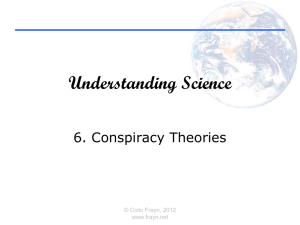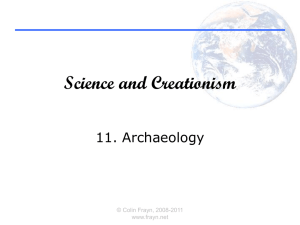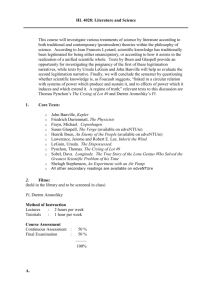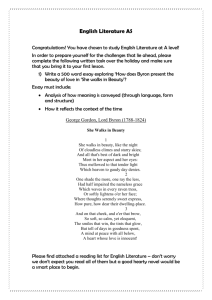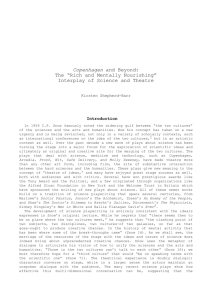Slides
advertisement
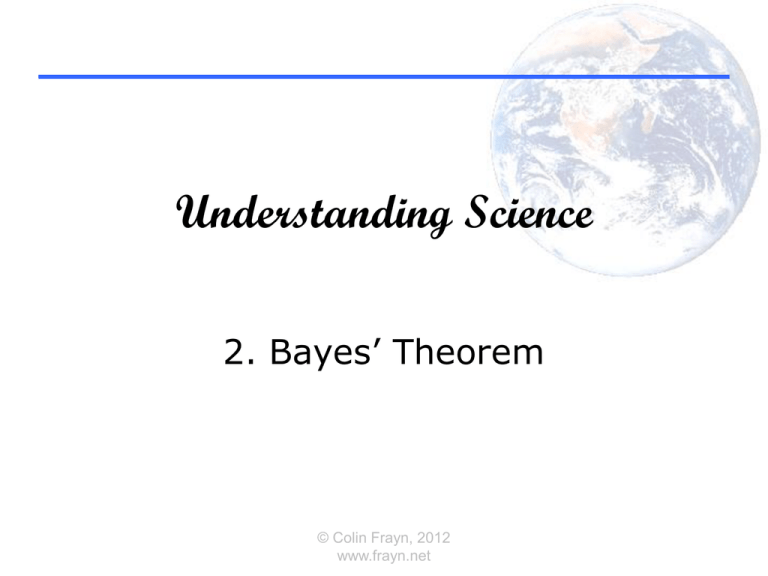
Understanding Science 2. Bayes’ Theorem © Colin Frayn, 2012 www.frayn.net Recap • Assumptions of science a) Underlying laws b) Accurate senses c) Occam’s Razor • Absolute proof – Can be achieved with mathematical claims – Difficult or impossible for scientific laws • Spectrum of certainty – Science moves theories on the spectrum • Scientific Theories – Empirical models – Well tested, predictive, falsifiable © Colin Frayn, 2012 www.frayn.net Clarifications • “False” does not imply “completely wrong” – E.g. Newtonian Physics vs. Relativity – E.g. the Flat Earth theory, the Spherical Earth theory • Carl Sagan’s Dragon – Can we show it doesn’t exist? – Should we bother? • Predictive laws versus specific statements – “There are no dragons” © Colin Frayn, 2012 www.frayn.net Introduction • New evidence arrives – What does that do? – Moving around the spectrum of certainty • Prior knowledge – Did you see Elvis? • When could we call something a “fact”? – A scientific fact is “near enough”! © Colin Frayn, 2012 www.frayn.net Examples • On trial for murder – DNA testing – Very accurate – …but a very large population • A rare disease – Rare disease or rare misdiagnosis – Intuition doesn’t help © Colin Frayn, 2012 www.frayn.net Organic Gravity – An Example Organic gravity ”Gravity only acts on organic things” Vs. Newtonian gravity “Gravity acts identically on every type of object” • Test 1 – drop an apple – Both theories are equal • Test 2 – drop a stone – Newtonian gravity wins © Colin Frayn, 2012 www.frayn.net In More Detail • Let’s look at what we just did • Test 1 didn’t really help – It didn’t differentiate – It provided equal support to each • Test 2 solved the issue – Distinguished between the proposals – Provided support to Newtonian theory © Colin Frayn, 2012 www.frayn.net Equal Support • What do we do when we cannot distinguish between two possibilities? • Look at the prior probability of each • Example: Diagnosing a rare disease 1. The patient has a rare disease 2. The test was wrong © Colin Frayn, 2012 www.frayn.net Putting it all together... Probability of a Hypothesis given the Evidence P(H|E) Depends on... 1. The support that E gives to H 2. The prior probability of H © Colin Frayn, 2012 www.frayn.net Finally, Bayes’ Theorem P (H | E) = P (E | H) * P (H) P (E) Prior Posterior Support © Colin Frayn, 2012 www.frayn.net Evidential Support • “How much does evidence E support hypothesis H?” – P(E|H)/P(E) • Eating garlic scares away vampires – Given that I don’t see any vampires • P(E) = 1 – Vampires don’t exist! • P(E|H) is also 1 – So test is useless – That is, it has no differentiating power © Colin Frayn, 2012 www.frayn.net Non-discriminating Evidence P( | ) = P( 1 | P( ) * P( ) Posterior probability is equal to the prior i.e. We’ve learned nothing whatsoever © Colin Frayn, 2012 www.frayn.net ) Priors • “What is the chance that our hypothesis might be true ignoring the new evidence?” – P(H) • A “flat prior” means “no preference” – P(H) is the same for all hypotheses • The “status quo” – E.g. “Elvis is alive” – … or any other conspiracy theory – … or and pseudoscientific claim © Colin Frayn, 2012 www.frayn.net Organic Gravity Revisited • Dropping an apple gave no preference – P(H) = 0.5 for both P(Newtonian | Stone Falls) = 1 P(Stone Falls1| Newtonian) * P(Newtonian) 0.5 P(Stone 0.5Falls) P(Organic | Stone Falls) = 0 0 | Organic) * P(Organic) P(Stone Falls 0.5 P(Stone 0.5Falls) © Colin Frayn, 2012 www.frayn.net Assumptions • Assumption of completeness – Don’t have to make this assumption – Though we do need some way to calculate P(E) • Assumption that the evidence was accurate – Can factor this into P(E|H) • Assumption that you understand your models – Do you really know P(E|H)? © Colin Frayn, 2012 www.frayn.net Summary • Bayes theorem allows us to update hypotheses in response to evidence • It evaluates the support that evidence gives for a hypothesis • It underlies all of science © Colin Frayn, 2012 www.frayn.net
